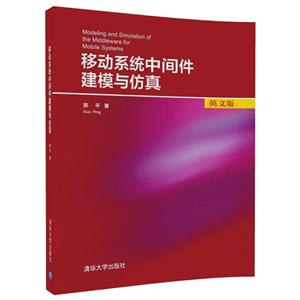移动系统中间件建模与仿真 版权信息
- ISBN:9787302491873
- 条形码:9787302491873 ; 978-7-302-49187-3
- 装帧:一般纯质纸
- 册数:暂无
- 重量:暂无
- 所属分类:>
移动系统中间件建模与仿真 本书特色
本书主要介绍基于软件架构的软件建模与设计的相关知识,以移动系统作为例子,展示了如何使用基于和UML类似的元建模和图形转换技术来解决实际问题,主要内容包括问题领域、建模语言、软件架构式样、仿真技术、细化技术以及工具支持与代码生成。本书不仅具有理论研究价值,而且具有较高的工程应用价值,对移动系统和软件架构软件建模感兴趣的研究开发者和工程师具有很好的参考价值。
移动系统中间件建模与仿真 内容简介
本书主要介绍基于软件架构的软件建模与设计的相关知识,以移动系统作为例子,展示了如何使用基于和UML类似的元建模和图形转换技术来解决实际问题,主要内容包括问题领域、建模语言、软件架构式样、仿真技术、细化技术以及工具支持与代码生成。本书不仅具有理论研究价值,而且具有较高的工程应用价值,对移动系统和软件架构软件建模感兴趣的研究开发者和工程师具有很好的参考价值。
移动系统中间件建模与仿真 目录
Chapter 1 Introduction 1
1.1 Motivation:middlewareformobilesystems .......... 1
1.2 Problemswitharchitecture-centricapproaches......... 4
1.3 Objectivesofthebook...................... 7
1.4 Ourapproach........................... 10
1.5 Structureofthebook ...................... 13
Chapter 2 The Problem Domain 15
2.1 Overview ............................. 15
2.2 Middle
2.3 Middle
2.3.1
2.3.2
2.3.3
2.3.4
2.4 Middle
2.4.1
2.4.2
2.4.3
2.4.4
warefordistributedsystems............... 16
wareformobilesystems ................. 22
Mobilesystems...................... 23
Mobileapplications.................... 24
Problemswithmobileapplicationdevelopment .... 26
Middlewareformobilesystems ............. 27
wareformobilesystems:examples ........... 32
Event-based(orpublish/subscribe)middleware ... 32
Tuplespace-basedmiddleware ............. 36
Objectandcomponentmiddleware........... 39
Generalizationofcommonalities ............ 42
2.5 Aspectstobemodeled...................... 44
2.5.1 Modelingmobility .................... 44
2.5.2 Modelingotheraspects ................. 46
Chapter 3 Related Work 49
3.1 Overview ............................. 49
3.2 Requirements........................... 50
3.2.1 Requirementsforstylespeci.cation........... 50
3.2.2 Requirementsforthemodelinglanguage........ 53
3.3 Surveyofrelatedwork...................... 55
3.3.1 Surveyofarchitecturalstyles .............. 55
3.3.2 Surveyofmodelinglanguages.............. 64
Chapter 4 An Overview of the Approach 68
4.1 Overview ............................. 68
4.2 Thearchitecturalstyleforthemiddleware........... 70
4.2.1 Middleware-inducedstyle ................ 70
4.2.2 Layeredstructureofthestyle.............. 71
4.3 Themodelingandsimulationframework............ 73
4.3.1 Style-basedmodeling................... 73
4.3.2 Thestyleforthemiddleware .............. 78
4.3.3 Re.nement ........................ 79
4.3.4 Simulation ........................ 82
Chapter 5 Architectural Style-based Modeling 86
5.1 Overview ............................. 86
5.2 BackgroundoftheTGTS .................... 87
5.2.1 Graphsandgraphmorphism .............. 87
5.2.2 Graphsandobject-orientedmodeling.......... 88
5.2.3 Rulesandgraphtransformation ............ 89
5.2.4 Metamodeling ...................... 91
5.2.5 Typedgraphtransformationsystemandstylespeci.ca-tion ............................ 92
5.3 Speci.cationofthestyle..................... 94
5.3.1 Structuralpart ...................... 95
5.3.2 Behavioralpart...................... 97
5.3.3 Syntaxandsemanticsofthemodelinglanguage.... 101
Contents vii
Chapter 6 Style Examples 104
6.1 Overview ............................. 104
6.2 Themiddlewarefornomadicnetworks ............. 106
6.2.1 Architecturalcommonalities............... 106
6.2.2 Theconcretemiddleware:WirelessCORBA...... 110
6.3 Conceptualstyle ......................... 117
6.3.1 Structuralpart ...................... 118
6.3.2 Behavioralpart...................... 120
6.4 Platform-independentconcretestyle .............. 123
6.4.1 Structuralpart ...................... 123
6.4.2 Behavioralpart...................... 125
6.5 Platform-specificconcretestyle:WirelessCORBA ......... 133
6.5.1 Structuralpart ...................... 133
6.5.2 Behavioralpart...................... 137
6.5.3 IDLsemanticsspeci.cation ............... 147
Chapter 7 Style Re.nement 149
7.1 Overview ............................. 149
7.2 Requirementsforthere.nement ................ 150
7.3 Existingapproachesandopenproblems ............ 156
7.4 Rulemapping-basedstylere.nement ............. 158
7.4.1 Structuralre.nement .................. 159
7.4.2 Behavioralre.nement .................. 162
7.4.3 Re.nementoftheTGTS-basedstyle ......... 183
7.5 Evaluationandcomparison ................... 184
Chapter 8 Style Simulation and Tools 187
8.1 Overview ............................. 187
8.2 Graphtransformationsimulationtools............. 189
8.2.1 Requirementsforthetool ................ 189
8.2.2 AGG............................ 191
8.2.3 PROGRES ........................ 192
8.2.4 Fujaba........................... 194
8.2.5 Evaluationandcomparison ............... 195
8.3 Style-basedsimulation ...................... 198
8.3.1 Stylespeci.cationandsimulation............ 198
8.3.2 E.cientvalidation.................... 204
8.3.3 Re.nementconsistencycheck.............. 207
8.3.4 Behavioralconsistencycheck .............. 208
8.3.5 Style-basedengineering ................. 216
Chapter 9 Conclusion 219
9.1 Evaluation............................. 219
9.1.1 Evaluatingthestylespeci.cation............ 220
9.1.2 Evaluatingthemodelinglanguage ........... 221
9.2 Relevancetopractice....................... 224
9.2.1 Styleanddesign ..................... 224
9.2.2 Theconceptualstyleanddesign ............ 225
9.2.3 Theplatform-independentconcretestyleanddesign . 227
9.2.4 Theplatform-speci.cconcretestyleanddesign .... 229
9.3 Contributions........................... 230
9.4 Futurework............................ 234
9.4.1 Industryprojectexperience ............... 234
9.4.2 Automationandtoolsupport.............. 235
9.4.3 Developmentofotherarchitecturalstyles ....... 236
9.4.4 Modelbasedtesting ................... 237
Appendix OMG Wireless CORBA IDL 239
Bibliography 249
List of Figures 265
List of Tables 270
展开全部
移动系统中间件建模与仿真 作者简介
郭平,现任职于昆明理工大学计算中心,曾获得德国帕德博恩大学的计算机博士学位。主要研究方向包括软件架构、软件建模、移动和系统、嵌入式系统等。曾任职于西门子研发中心软件工程师,德国国家印刷厂高级软件架构师,Capgemini咨询师等。















